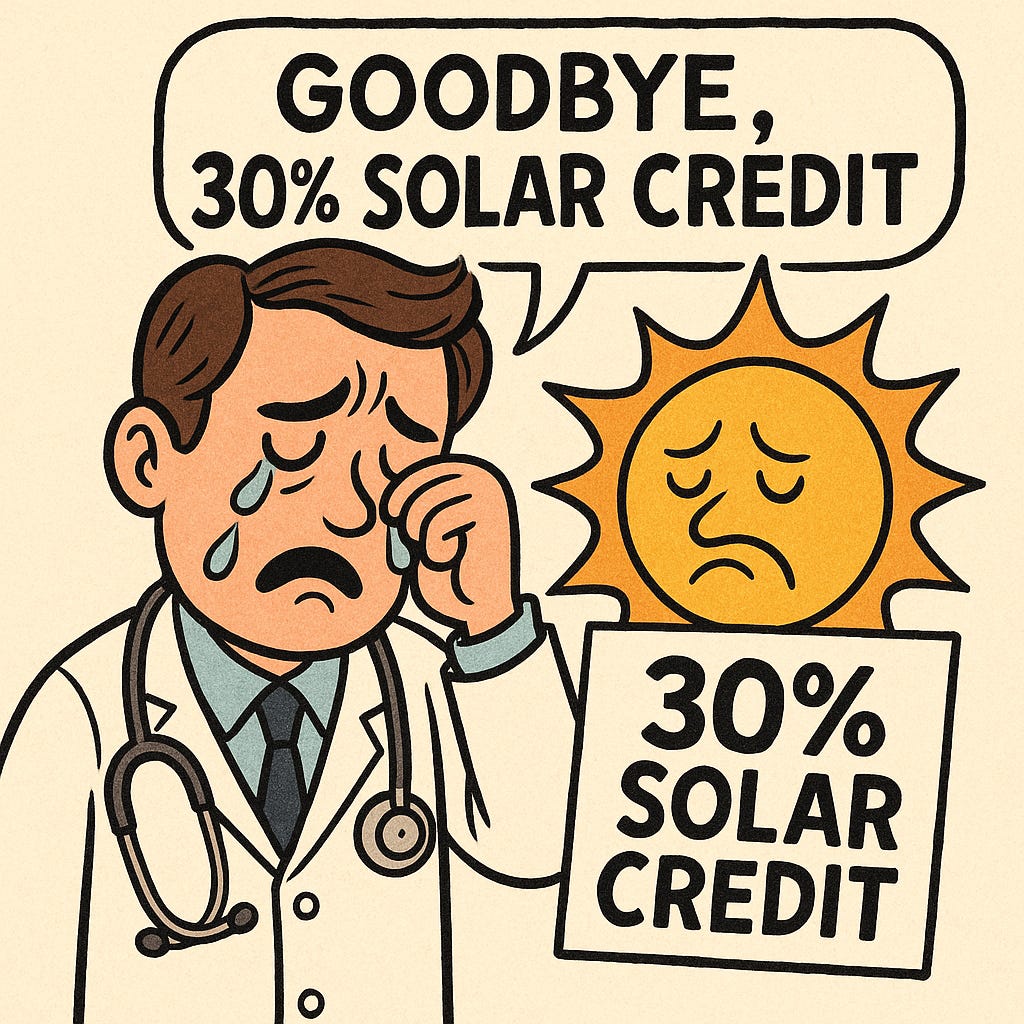Doctors, Hurry Up and Buy: OBBB Update – Part 5
30% tax credit on solar ending soon.
⚠️ Attention Doctors: This is a time-sensitive update for homeowners!
Congress just pulled the plug - but not before giving you one last chance.
The One Big Beautiful Bill (OBBB) quietly killed off the Residential Clean Energy Credit under IRC §25D - but here’s the twist.
It’s still alive through December 31, 2025.
That means you have time - but not much.
This generous 30% federal tax credit for solar panels and battery systems (like the Tesla Powerwall) was originally supposed to stick around until 2034.
Now? It’s dead 9 years early.
DNR’d too soon (even as a palliative care doc myself, this one stings).
So if you’ve been thinking about going solar or beefing up your home’s energy storage, this is your wake-up call.
Act now or miss your chance to claim thousands in tax credits - forever.
What Do I Have To Do Now?
Simple: Get your solar system installed by December 31, 2025.
That’s it.
The key word here is “installed.” It doesn’t have to be turned on, activated, or connected to the grid (which is a relief, because if you’re in California, PG&E permit delays are practically a rite of passage).
As long as your solar panels or battery system are physically installed by the end of 2025, you qualify for the 30% federal tax credit.
So don’t wait, installer calendars will fill up fast, and supply chain delays aren’t going away.
Lock it in while you still can.
What Solar System Qualifies for the Residential Clean Energy Credit?
Here’s the great news: a wide range of solar-related expenses qualify for the full 30% credit - including:
Solar panels
Battery storage systems (like the Tesla Powerwall)
Installation costs, including labor, wiring, prep work and permit fees
And yes - even high-income doctors qualify.
There’s no income limit for claiming this credit .
So, if you spend $50,000 to install solar and battery, you can get a $15,000 tax credit on your federal return.
One catch: the systems must be installed on your primary residence or a vacation home, not a rental.
Special Situations
1. Buying a New Home With Solar Panels?
If you’re purchasing a newly built home with solar (which is becoming more common, especially in California), you - the homeowner who uses the home as a primary or vacation home - get the credit.
Pro tip: Ask the builder to break out the cost of the solar system in your purchase contract. You’ll need that to claim the credit on your tax return.
2. What About Rental Property?
Sorry - pure rental properties don’t qualify for the §25D Residential Clean Energy Credit.
But don’t give up just yet.
If you’re installing solar on a rental, you might be eligible for the §48 or §48E business energy credits instead. Those fall under a different part of the tax code - and OBBB didn’t fully kill them (yet).
State Credits, Utility Incentives and Basis adjustments
State Credits:
Good news: state solar tax credits do NOT reduce your federal tax credit.
So if you live in a state like Arizona or New Mexico, you can double-dip.
Example:
Solar panel and installation cost: $50,000
New Mexico tax credit: $5,000
Federal credit: still 30% of $50,000 = $15,000
Your federal credit is calculated on the full amount you paid - not reduced by the state benefit.
Utility Rebates:
Now, here’s where you have to be careful.
If you receive a non-taxable (i.e., tax-free) utility rebate, it does reduce the amount eligible for the federal credit.
Example:
Solar panel and installation cost: $50,000
Utility rebate: $5,000
Eligible basis for federal credit: $45,000
Federal credit = 30% of $45,000 = $13,500
So always check how your rebate is classified
Taxable rebate => no reduction.
Non-taxable rebate => reduces credit.
Basis Adjustments (This Matters When You Sell)
Any credit you receive - federal or state - reduces your tax basis in the system.
Example:
Solar panel and installation cost = $50,000
Federal credit: $15,000
State credit = $5,000
Your basis = $30,000 ($50,000 - $15,000 - $5,000)
Let’s say, hypothetically, you somehow sell your solar system (rare, but not impossible) for $40,000, you could have a $10,000 taxable gain ($40,000 - $30,000) because of the lower basis.
What Should You Do Now?
If you’re thinking about going solar or adding battery storage, it’s go time.
Here’s what to do:
Act fast. The system must be installed by December 31, 2025.
Get multiple quotes and book early. Installers will be slammed as the deadline approaches.
Confirm eligibility. Make sure your system qualify for the federal credit under IRC §25D.
Buying a new build? Ask the builder to itemize solar costs in your purchase agreement so you can claim the credit.
Run the math. A $50K install = a $15,000 tax break (assuming no non-taxable rebates). This is real savings, even in a high tax bracket
Final Thoughts
This credit was never supposed to die this early—but OBBB did it (and no, not OJ).
If you’ve been dragging your feet on solar, now’s the time to act.
OBBB just lit a fire under the timeline.
You’ve got until December 31, 2025 to lock in a 30% federal tax credit for residential solar and battery installs.
After that?
It’s gone for good.
Get moving—before Congress pulls the plug.
Disclaimer: click here



